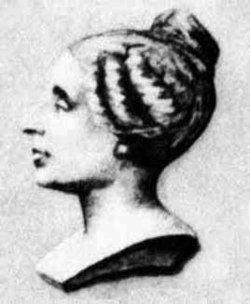索菲·熱爾曼
法國數學家,物理學家和哲學家 来自维基百科,自由的百科全书
瑪麗-索菲·熱爾曼(法語:Marie-Sophie Germain,1776年4月1日—1831年6月27日),是一名法國女數學家、物理學家和哲學家。

熱爾曼所處的時代不支持女性接受教育,並且她的父母也不支持,但她從她父親圖書館裏的書中自學,並以筆名「勒布朗先生」(Monsieur LeBlanc)與當時著名的數學家如約瑟夫·拉格朗日、阿德里安-馬里·勒讓德和卡爾·弗里德里希·高斯等書信往來。她是彈性理論的先驅之一,她在費馬大定理上的研究為後世數學家提供了堅實基礎。[1]由於當時對女性的偏見,她無法將數學作為事業,但她一生都在自行獨立地工作。[2]高斯曾舉薦哥廷根大學授予她榮譽學位,但授予時她已因乳腺癌去世。在熱爾曼百年誕辰之際,法國科學院為紀念她設立了索菲·熱爾曼獎。
早年
1776年4月1日,索菲·熱爾曼出生於法國巴黎聖但尼路的一個中產階級家庭。父親安布瓦斯-弗朗索瓦·熱爾曼(Ambroise-François Germain ,1726-1827)是一名富有的絲綢商人,[3][4][5],母親是瑪麗·瑪德琳·格魯古倫(Marie-Madeleine Gruguelun)[6] 。1789年,父親當選為資產階級的代表,出席1789年法國三級會議,並見證了該議會演變為立憲制制憲會議。人們認為熱爾曼耳濡目染了父親與其朋友之間關於政治和哲學的許多交流。政治生涯結束後,他成為了一家銀行的董事,家庭仍然富裕,足以支持熱爾曼度過以後的成年生活。[7]
熱爾曼13歲時,巴士底獄被市民攻陷,巴黎的革命氣氛迫使她待在家中。為了消遣,她轉向父親的圖書館。在此,她讀到了法國數學家讓·艾蒂安·蒙圖克拉的《數學史》(L'Histoire des Mathématiques),其中阿基米德死於羅馬士兵之手的故事引起了她的興趣[4],同時她也對阿基米德產生崇拜之情,萌生了自己也要成為數學家的想法。[8]熱爾曼仔細地閱讀圖書館中每一本關於數學的書籍。為了能夠讀懂歐拉和牛頓的著作,她還自學了拉丁語和希臘語以及幾何、代數和微積分。[8]之後,表弟拜訪熱爾曼家,並鼓勵她學習。[9]
熱爾曼的父母完全不支持她對數學突然產生的興趣,同時在當時那個年代普遍不支持女性受教育。每當在晚上,父母不讓她穿暖和的衣服,也不給她的臥室生火取暖,試圖阻止她學習。但當父母離開後,她會點燃蠟燭,裹上被褥取暖學習數學。[10]一段時間過後,她的母親甚至暗中支持她學習。[9]
1794年,這時熱爾曼18歲,巴黎綜合理工學院成立。[5]作為女性,她被禁止入學,但新的教育體系允許「所有提出要求的人都可以獲得講義」,[9]新的教育方法還要求學生提交與課程相關的分析和思考[11]。熱爾曼從學生安托萬·奧古斯特·勒布朗(Antoine Auguste Le Blanc)那裏拿到了學院的講義,然而勒布朗後來在法國大革命中去世,因而無法再給熱爾曼提供幫助,於是她開始通過自學繼續深造。在勒布朗去世後,熱爾曼以他的名字將自己對練習題的解答郵寄給拉格朗日,請他予以糾正。[12][9][13]之所以她要以勒布朗的名字進行交流,是因為如她後來對高斯說的那樣,「害怕對女性科學家的嘲笑」[14]。對她所提交的內容感到滿意後,拉格朗日邀請與「勒布朗」進行面對面交流,最終熱爾曼不得不出面解釋自己的真實身份。幸運的是,拉格朗日不介意熱爾曼的女性身份,還十分欣賞這位才華橫溢的學生,並公開鼓勵她。[9][12]拉格朗日也成為了熱爾曼的導師。[5]
數論的早期研究
1804年,她讀完高斯的《數學研究》(Disquisitiones Arithmeticae)後,又以勒布朗之名和高斯通信。1806年高斯洞悉其身分,但反而表示敬佩她的精神。1808年,高斯的興趣轉到應用數學,他們之間的通信便中斷了。
參見
參考資料
Wikiwand - on
Seamless Wikipedia browsing. On steroids.

